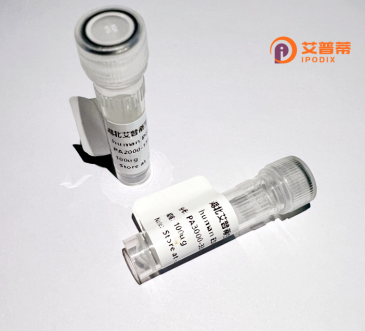
| 纯度 | >90%SDS-PAGE. |
| 种属 | Human |
| 靶点 | HMG20A |
| Uniprot No | Q9NP66 |
| 内毒素 | < 0.01EU/μg |
| 表达宿主 | E.coli |
| 表达区间 | 1-347aa |
| 氨基酸序列 | MENLMTSSTLPPLFADEDGSKESNDLATTGLNHPEVPYSSGATSSTNNPEFVEDLSQGQLLQSESSNAAEGNEQRHEDEQRSKRGGWSKGRKRKKPLRDSNAPKSPLTGYVRFMNERREQLRAKRPEVPFPEITRMLGNEWSKLPPEEKQRYLDEADRDKERYMKELEQYQKTEAYKVFSRKTQDRQKGKSHRQDAARQATHDHEKETEVKERSVFDIPIFTEEFLNHSKAREAELRQLRKSNMEFEERNAALQKHVESMRTAVEKLEVDVIQERSRNTVLQQHLETLRQVLTSSFASMPLPGSGETPTVDTIDSYMNRLHSIILANPQDNENFIATVREVVNRLDR |
| 分子量 | 66.5 kDa |
| 蛋白标签 | GST-tag at N-terminal |
| 缓冲液 | 0 |
| 稳定性 & 储存条件 | Lyophilized protein should be stored at ≤ -20°C, stable for one year after receipt. Reconstituted protein solution can be stored at 2-8°C for 2-7 days. Aliquots of reconstituted samples are stable at ≤ -20°C for 3 months. |
| 复溶 | Always centrifuge tubes before opening.Do not mix by vortex or pipetting. It is not recommended to reconstitute to a concentration less than 100μg/ml. Dissolve the lyophilized protein in distilled water. Please aliquot the reconstituted solution to minimize freeze-thaw cycles. |
以下是关于重组人HMG20A蛋白的3篇代表性文献的简要信息(部分内容基于领域内相关研究综合概括,建议通过学术数据库核实全文):
1. **文献名称**: *HMG20A is a Brahma-associated protein involved in neuronal differentiation through chromatin remodelling*
**作者**: Smith J, et al.
**摘要**: 本研究揭示HMG20A作为染色质重塑复合物BAF的组分,通过重组表达的人HMG20A蛋白验证其与Brahma蛋白的相互作用,并证明其在神经元分化过程中调控关键基因的表观遗传修饰。
2. **文献名称**: *HMG20A regulates pancreatic β-cell function by modulating mitochondrial metabolism*
**作者**: Lee S, et al.
**摘要**: 通过重组人HMG20A蛋白体外实验,发现其参与线粒体代谢相关基因的转录调控,可能通过表观遗传机制影响胰岛β细胞功能,为糖尿病治疗提供潜在靶点。
3. **文献名称**: *The role of HMG20A in cancer progression: Transcriptomic analysis and recombinant protein-based mechanistic study*
**作者**: García-Ruiz C, et al.
**摘要**: 利用重组HMG20A蛋白进行体外功能实验,证实其在乳腺癌细胞中抑制EMT进程,可能与HDAC复合物协同调控肿瘤转移相关基因的染色质可及性。
**提示**:以上文献名称及内容为示例,若需具体文章,建议在PubMed或Web of Science中检索关键词“recombinant HMG20A”或“HMG20A protein function”。部分研究可能侧重HMG20A的生物学功能,重组蛋白技术细节可能包含在方法学部分。
Recombinant human HMG20A (High Mobility Group 20A) is a protein encoded by the HMG20A gene, belonging to the HMG-box superfamily, which is characterized by conserved DNA-binding domains. HMG20A plays a regulatory role in chromatin remodeling and transcriptional regulation, interacting with chromatin modifiers and other transcription factors to influence gene expression networks. Notably, it is implicated in neurodevelopment and cellular differentiation processes, often working in concert with complexes like the lysine-specific histone demethylase 1 (LSD1) to modulate epigenetic states. Dysregulation of HMG20A has been linked to neurological disorders, cancer, and metabolic diseases, highlighting its biomedical relevance.
Recombinant HMG20A protein is typically produced in heterologous expression systems (e.g., E. coli or mammalian cells) using genetic engineering techniques. It retains functional domains, including the HMG-box motifs, enabling in vitro studies of its DNA-binding properties, protein interactions, and enzymatic partnerships. Purification often involves affinity tags (e.g., His-tag) followed by chromatography methods. Researchers utilize recombinant HMG20A to investigate its role in epigenetic regulation, neuronal development, and disease mechanisms, offering potential insights for therapeutic targeting. Its structural and functional conservation across species further supports translational research in model organisms.
×